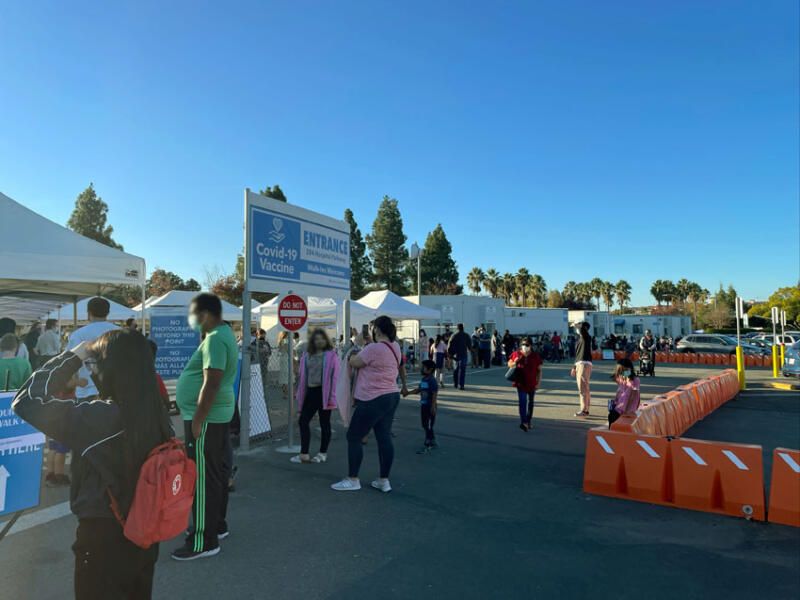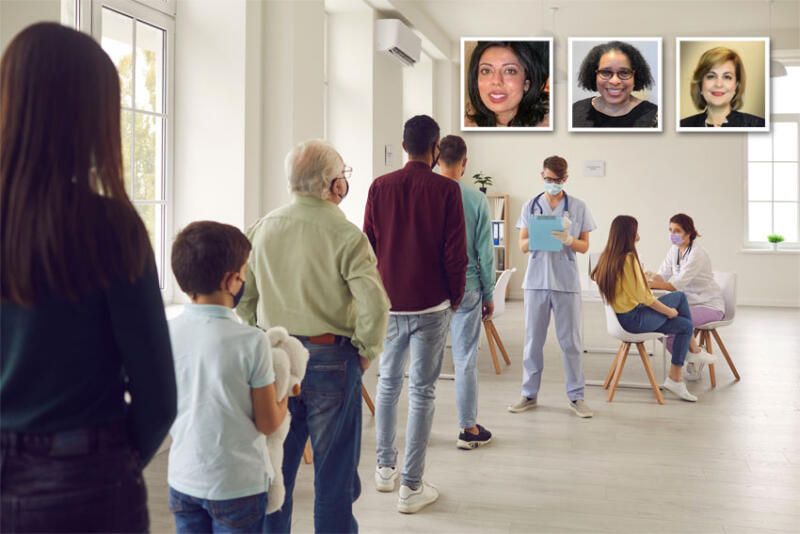Medical Practitioners Plea: Vaccinate Yourself, Your Kids Five or Older Today, It’s Safe!
(Above, Inset: l-r): Monica Gandhi, MD, MPH, Professor of Medicine, UC San Francisco’s School of Medicine; Jennifer Miller, MD, Pediatrician, East Bay Pediatrics; and Maria Meraz, Founder-Director, Parent Engagement Academy in Los Angeles. (Siliconeer/EMS)
At a briefing hosted by Ethnic Media Services, Nov. 12, the focus was once again at the Covid 19 pandemic and the effort to vaccinate some 28 million 5-to-11-year-olds in the United States. As per news accounts at the time of this event, some seven hundred thousand five-to-eleven-year-olds have been vaccinated as of the first week. This follows the endorsement by CDC director Rochelle Walensky of the recommendation of the CDC Advisory Group on Immunization Practices.
Infection rates have begun to inch upward. Could this new drive mark a turning point in the battle to contain the pandemic? What are those on the front lines with our kids seeing one week into the campaign? Four speakers – Monica Gandhi, MD, MPH, Professor of Medicine, UC San Francisco’s School of Medicine; Jennifer Miller, MD, Pediatrician, East Bay Pediatrics; Maria Meraz, Founder-Director, Parent Engagement Academy in Los Angeles; and Madison Sandoval, a school nurse, who has worked in Bay Area schools – weigh in on the need for a complete and effective vaccination of our child population.
Q: How significant is vaccinating the 5-to-11-year-old age group in the battle to contain COVID 19? Does it represent a research breakthrough? How long before we’ll be able to vaccinate children four months or six months to four years?
A: Dr Gandhi: On September 20 we got the top line results from Pfizer and BioNTech from a trial among children 5-to-11-years-old and this was really designed to look at the vaccine for safety and immunogenicity. There were 2,268 children in the trial. There were enhanced antibody responses in those who got the vaccine and though there were only a handful of symptomatic COVID infections, there were enough to show a difference, a reduction in COVID symptomatic infections among children.
The three premises why we think childhood vaccine is important to give – First, there is no doubt that children are less at risk for severe disease from COVID. In fact, it is sometimes the failure to have recognized that, that has led to unfortunate consequences like prolonged school closures in some states in the U.S.
During the delta surge there were increased hospitalizations and deaths among children five-to-eleven with the delta variant, though it pales in comparison to what happened in the adults in this country with 718,000. We suffered unfortunately childhood hospitalizations and deaths during the delta surge mainly in places with low rates of adult vaccination and it is that premise that led us to say that children should be vaccinated mainly for their own benefit against COVID 19. Even though the risk is lower, and it is the eighth leading cause of death, during the delta variant surge in children, it was the eighth leading cause of death in this country. If you had a shot, a pill, that would prevent any other cause of death among children, accidents or cancer or the other leading causes of death we would take that pill or that shot, if the medication or the product that we were giving is safe. It absolutely reduces transmission to others for children to get vaccinated because we all live in communities and we live with older parents and grandparents and that is an absolutely acceptable reason.
Parents are concerned about safety and dosage. There are ways to ensure that we have maximal safety of this vaccine and also administer it. The dose of vaccine for the Moderna vaccine that many adults received is a 100 mcg. That dose has not been approved for 12-to-17-year-olds in the U.S. Those under 30 should not receive the Moderna vaccine because of increased risk of myocarditis. For the Pfizer vaccine, dosage for 12-to-15-year-olds is 30 micrograms. That is the dose that 12-to-15-year-old will have received and that is the dose that that adults will have received, however, the dose for the children 5-to-11 is 10 microgram and the reason that that dose was chosen is not actually because of weight, because it is not actually weight-based. Children have a very active immune response and even at 11, after two to three months of age, they have a very robust immune system that’s where the immune maturity is reached, and they will respond actively to even less of a dose.
There are reasons to believe that there is better effectiveness and safety if the 10 microgram doses for 5-to-11-year-olds are given with longer spacing in between. This is not a CDC ACIP recommendation, this is a recommendation that I make as an infectious disease doctor and someone who is familiar with principles of vaccinology that three weeks between doses are very short, in fact only the Rabies vaccine has three weeks between doses but usually a principle of vaccinology is to give the prime dose and then a booster or the second dose later to give time for the immune response to form.
Q: In vaccinating 5-to-11-year-olds, how close do we get to that 80 percent herd immunity?
A: Dr Gandhi: The phrase herd immunity has really disappeared after the emergence of the delta variant because in strict definitions of infectious disease epidemiology this highly transmissible variant made it difficult to get to herd immunity. Instead, there is a concept in infectious disease called control. We will always have to be vigilant about vaccinations and treatment for those who decline vaccination, which very thankfully, two antiviral treatments are on their way in the next month-and-a-half. Control means we vaccinate as much of the population as we can and have immunity in as much of the population as we can, which keeps the virus to lower levels.
It is true that 5-11-year-olds being vaccinated would be extremely helpful because we are still at about a 68 percent full vaccination rate across the country. The 28 million children will add more to our immune pool and have the virus be able to find fewer and fewer susceptible hosts. Natural immunity will also lead to more immunity in the population.

Dr Miller gave a perspective from a pediatrician on the front lines.
“Parents started beating my door down, we received phone calls, emails, and text messages of families that were just eagerly awaiting the vaccine for their children. They were very excited to be able to come in. Kids are never excited to get vaccines and now kids were excited to get vaccinated,” said Dr Miller.
“Families were looking forward to being able to resume some semblance of normalcy in their lives, they did have to not worry about having to isolate and quarantine. They could be able to spend full time at school and not worry about getting sick. Families could think about traveling together as the holidays come,” said Dr Miller.
“One group of patients were very eager and then there’s the other group of patients who have been more cautious and more hesitant. We definitely are seeing this more commonly in communities of color and minority communities but not across the board. All my hesitant patients are not necessarily families of color but these families took a pause and they really were interested in waiting and seeing,” said Dr Miller.
Some of the comments Dr Miller received from her patient families: “I’m vaccinated. I believe in it. I believe in science.” “I know I’m vaccinated but I’m afraid to get my children vaccinated. I’m afraid because they might have long-term consequences that I don’t even know of now. I’m afraid because they may have side effects and I’m afraid to have that power, to make that decision.”
“Some conversations out and about are about fertility. Families are concerned that there’s going to be some impact of fertility if we give the vaccine to children, and all the data has shown that there’s no involvement, no effect on fertility, this is a great vaccine it does not change the DNA and it does not affect the fertility of our patients,” said Dr Miller.
Families are also worried about myocarditis, as the inflammation in the heart, and so some of them say “I want to wait and see and see how that goes.”
“We know that the COVID virus itself causes myocarditis, and of the patients who did get myocarditis, that got vaccinated, they were all generally mild cases. They were cases that went away on their own and they were cases that did not have long-term consequences. I’ve seen both groups in my office which has been quite interesting. The wait-and-see group has concerned me because in the last 20 months I’ve experienced dealing with such high numbers of suicidality depression and anxiety. Not only are we dealing with a pandemic because of COVID, but we’re dealing with a mental health pandemic. We’re seeing that these children and adolescents who have been removed from everything that they know is normal – their schoolwork; their peers; their sports; their clubs; their activities – are depressed and anxious. They’re worried because they’ve lost family members to COVID. They’re sad, they’re depressed because they can’t be around their friends because their families have been so worried about spreading the virus and the hope for us was that once school started the depression and anxiety would get better, and it has a little bit, but there’s a very large number of patients that are still really suffering from depression and anxiety for the first time,” said Dr Miller.
“I have an eight-year-old patient who’s cutting self-harm because her anxiety is so high. I have patients that have been admitted to the hospital for suicidal thoughts,” said Dr Miller.
Dr Miller is concerned about families that wait and see or families that don’t want to get their kids vaccinated, “We’re going to continue to see this mental health crisis. Families are going to be so afraid that they’re not going to vaccinate their kids and they’re going to keep them out of school and that worries me because I know these kids need to go back to school, they need to resume their normal life. The other thing that we’re seeing that concerns me is the educational disparities. A whole group of kids lost out a year of education and that’s a concern. Then there are kindergarteners that didn’t learn how to read because they were on Zoom and kids that have special needs that didn’t get their services, they didn’t get their occupational therapy and their physical therapy because they weren’t in the schools – these educational disparities occurred much more commonly in families of color and it concerns me if those families do not go out and get vaccinated that these kids will continue to fall behind and won’t be able to compete with their peers,” said Dr Miller.
“We are seeing that the numbers are going up in California. They’ve started to uptick lately which is very concerning because in California, we’re a better vaccinated group of people. The holidays are coming around and that’s when the flu typically spreads because people come together. COVID will be the same. It’s more important to get your kids vaccinated now before the holidays to prevent the spread as much as possible,” said Dr Miller.

Meraz, founder and director of Parent Engagement Academy, an organization in Los Angeles, that works with thousands of immigrant parents largely immigrant parents, shared her experience of how parents were reacting to the availability of vaccine for the 5-to-11-year-olds.
Sandoval, a school nurse has spent considerable time with young people in schools. The one person they always refer to as neutral and supportive is the school nurse.
Sandoval had recently switched from school nursing to public health nursing. She says, “I’ve definitely seen a lot of kids that see this as this is how they’re going to get back to some level of normalcy and this is how they’re going to feel safe in schools. The most nervous question I had is – ‘Is the needle big?’ ‘Can I just say no?’ – It’s no different than the normal needles that you get with the vaccine but a lot of the kids are actually excited around being able to get something that provides them with the level of security.”


